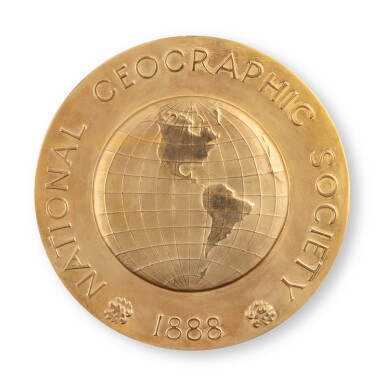
Property from the Buzz Aldrin Family Trust
Buzz Aldrin's 1970 National Geographic Society Hubbard Medal
Auction Closed
July 26, 06:15 PM GMT
Estimate
5,000 - 8,000 USD
Lot Details
Description
National Geographic Society Hubbard Medal, 1970. 3 1/2 inches in diameter, base metal, obverse with globe showing Western Hemisphere, encircled at outside by "National Geographic Society/1888." Reverse encircled at outside by animal and globe designs, tall ship to bottom center, reading "The Hubbard Medal," with central tablet incused, "Awarded to/APOLLO 11 CREW/Neil Armstrong, Commander/Edwin E. Aldrin, Jr./Michael Collins/American Astronauts First To Land On/The Mysterious Moon/Set Up Scientific Instruments And/Begin Its Exploration, July 20, 1969/"One Giant Leap For Mankind"/Washington, D.C. February 16, 1970." 11.3 ounces.
Housed in original square wood case, interior lined with blue velvet, yellow pull ribbon affixed to bottom center, blue plush matting to underside of case. Metal medallion, 1 1/4 inches, affixed to top of box with depiction of globe showing Western Hemisphere, encircled at outside by, "National Geographic Society/Incorporated A.D. 1888."
Directly from the Personal Collection of Apollo 11 Lunar Module Pilot Buzz Aldrin
BUZZ ALDRIN'S 1970 NATIONAL GEOGRAPHIC SOCIETY HUBBARD MEDAL
The Hubbard Medal is the National Geographic Society's highest honor, authorized by the Society's Board of Trustees in 1906 to "honor outstanding explorations or discoveries." The award was first presented to explorer Robert E. Peary in 1906 by President Theodore Roosevelt for Peary's Arctic explorations to the farthest north position reached at that time (North 87°, 6'). The medal had only been awarded 24 times before being presented to the Apollo 11 Crew, to such luminaries as Roald Amundsen, Ernest Shackleton, Richard Byrd, Charles Lindbergh, Louis Leakey, John Glenn, and the Apollo 8 Crew.
The awards were presented to Armstrong, Aldrin, and Collins by Vice President Spiro Agnew, who told the crew that they had, "won a place alongside Christopher Columbus in American history." One of the previous awardees, John Glenn, said in his 1962 acceptance speech that, "In time, an American astronaut will orbit the earth for 24 hours. Then, for a week. After that, an American will orbit the moon. And then, a dream man has had since the dawn of history will come true: An astronaut will land on the moon." The Apollo 11 crew made that dream a reality on July 20, 1969.
REFERENCES:
NASA Scientific and Technical Information Office. "Astronautic and Aeronautics, 1970: Chronology on Science, Technology, and Policy." NASA History, https://history.nasa.gov/AAchronologies/1970.pdf
CONDITION REPORT:
To request a condition report for this lot, please email science@sothebys.com
